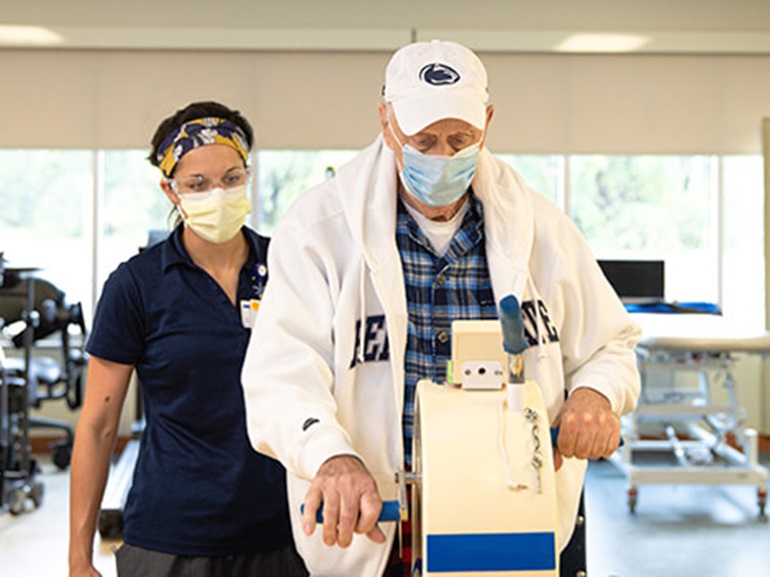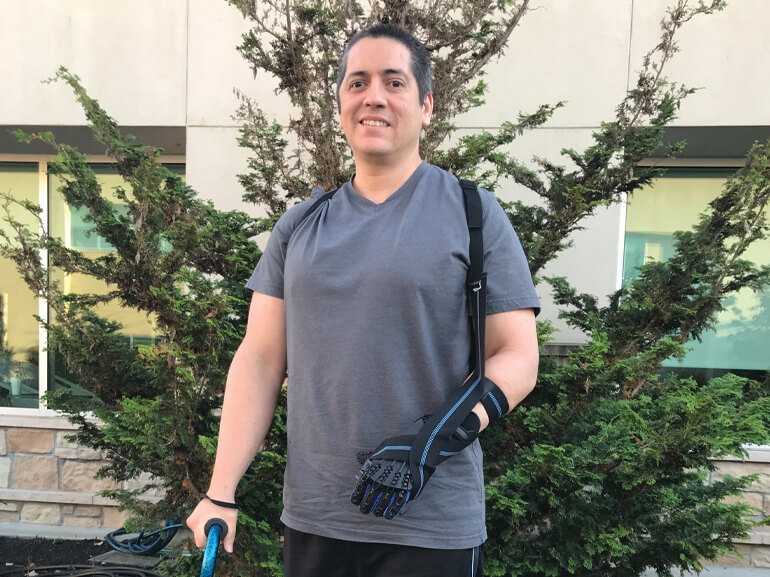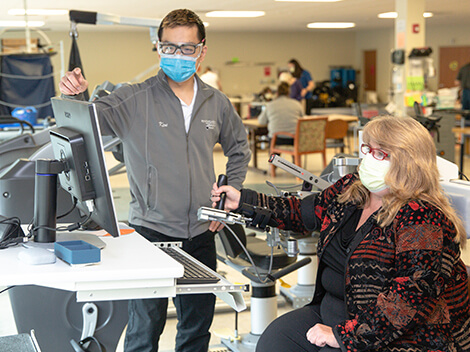Stroke rehabilitation
Recovering from a stroke can be one of the greatest challenges you will face, and where you go for treatment can make a difference. The American Heart Association and American Stroke Association recommend that, whenever possible, patients recovering from a stroke be treated in an inpatient rehabilitation hospital rather than a skilled nursing facility.1 The goal of our comprehensive stroke rehabilitation program is to help you increase your independence and physical functioning, as well as enhance your quality of life.
1Guidelines for Adult Stroke Rehabilitation and Recovery. American Heart Association, Inc. 2016

What sets us apart
Penn State Health Rehabilitation Hospital treats patients with a wide range of complex medical, physical, cognitive and emotional needs. This gives us unparalleled expertise and experience to address your individual challenges, goals and hopes for the future.
-
Stroke survivors who choose an inpatient rehabilitation hospital like Penn State Health Rehabilitation Hospital have greater improvement, fewer complications and are able to return home sooner than those treated at nursing facilities or other settings.1,2,3 At Penn State Health Rehabilitation Hospital, you’ll find a highly individualized, carefully integrated program of stroke care that has been shown to make the difference in patients’ outcomes.
1Guidelines for Adult Stroke Rehabilitation and Recovery. American Heart Association, Inc. 2016.
2Comparison of Functional Status Improvements Among Patients with Stroke Receiving Postacute Care in Inpatient Rehabilitation vs. Skilled Nursing Facilities. JAMA. 2019.
3Assessment of Patient Outcomes of Rehabilitative Care Provided in Inpatient Rehabilitation Facilities (IRFs) and After Discharge.
-
"Stroke rehabilitation requires the sustained and coordinated effort of a large inter-professional team. Communication and coordination among team members is paramount in maximizing the effectiveness and efficiency of rehabilitation."1 — American Heart Association and American Stroke Association
At Penn State Health Rehabilitation Hospital, we draw on the knowledge of an experienced team of stroke rehabilitation specialists to address the range of medical, physical, functional and emotional issues you face.
This inter-professional team is led by a physiatrist, a physician board-certified in physical medicine and rehabilitation and includes rehabilitation nurses; physical, occupational, speech and recreation therapists; neuropsychologists; dietitians; case managers and other clinical and support staff as needed.
1Guidelines for Adult Stroke Rehabilitation and Recovery. American Heart Association, Inc. 2016.
-
Studies show that the sooner you begin a highly coordinated, comprehensive stroke rehabilitation program, the greater gains you are likely to achieve.1 As a specialized hospital, Penn State Health Rehabilitation Hospital offers you an early start to rehabilitation. We work closely with you, your family and the referring hospital to ensure a smooth transition to our program.
Here you will benefit from a minimum of three hours of physical, occupational and/or speech therapies a day, five days a week. The skills and strategies you learn during therapy will be reinforced by your nursing team and in recreational activities.
Depending on the nature and extent of your stroke, you may be provided with a wheelchair and/or other assistive equipment including electronic aids to assist with daily tasks during your admission.
You and your family will also receive education and training to help maintain your overall health and well-being following discharge.
When you’re ready, we’ll coordinate your discharge, help arrange for equipment and provide access to community resources that may be available to you. Our goal, like yours, is for you to move forward with as much independence and confidence as possible.
1Guidelines for Adult Stroke Rehabilitation and Recovery. American Heart Association, Inc. 2016.
-
Treatment is carefully integrated and tailored to your specific needs and goals. Depending on the extent to which you have been impacted by a stroke, we will help:
- Restore physical function and the ability to perform daily activities
- Gain strength and endurance
- Improve balance and mobility
- Overcome speech or communication deficits
- Address swallowing issues or nutritional concerns
- Develop new cognitive, communication and behavioral strategies
- Improve vision deficits
- Deal with emotional, psychological and/or social challenges
- Return to home, work, school or community activities with as much confidence and independence as possible
Penn State Health Rehabilitation Hospital’s highly individualized program will also help to maximize recovery for patients whose needs may be complicated by other existing medical conditions.
-
To help you return home and resume work, school, community and/or social activities, Penn State Health Rehabilitation Hospital provides an unparalleled continuum and continuity of care. We are here to help you manage your health from inpatient to outpatient care.

The technology of stroke recovery

To support your recovery, Penn State Health Rehabilitation Hospital brings innovation and leading-edge technologies to treatment– and continues to research the most promising new avenues of care.
Below are some of the many advances now available to appropriate patients:
- Robotic therapies, including exoskeletons, the Armeo Spring Trainer®, and ReoGO®, to optimize motor recovery
- Body-weight supported treadmill training and electrical stimulation devices to improve balance, gait and walking
- Constraint induced therapy, a specialized approach to increase the use of the affected limb; electrical stimulation; mirror therapy and other strategies to improve arm and hand function
- Electrical stimulation to reduce muscle atrophy
- Prism adaptation therapy that involves the use of special goggles and the Bioness Integrated Therapy System® (BITS), a computer-based program to address vision difficulties
- Devices, like Lingraphica®, to augment or improve speech and communication
- Videofluoroscopy, a special type of x-ray, and VitalStim® a non-invasive external electrical stimulation therapy to diagnose and treat swallowing disorders
- Computer-based exercises to improve cognition (memory, concentration, decision-making and other skills)
- Medications to manage spasticity
- Equipment, including voice-activated devices, that allows individuals to turn on lights, a television, etc. with greater ease and independence.
- Adaptive gaming and other platforms to help individuals participated in recreational and social activities.